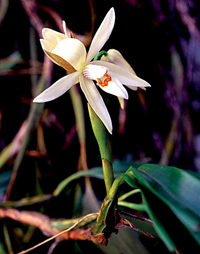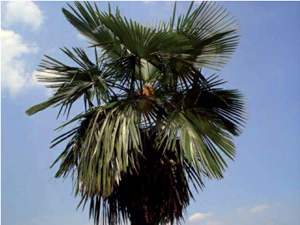Himalayas: Vulnerable species at mountainous crossroads
10/08/09
A new report by WWF - The Eastern Himalayas: Where Worlds Collide - describes more than 350 new species living at a geographical and ecological crossroad.

Eastern Himalayas
Murat Selam / WWF Nepal
The landscape is vast, rugged and beautiful but it's the diversity of life that is astounding scientists. Over 350 new species have been discovered in the last decade including 244 plants. Many areas are still to be explored and at this rate the biodiversity capital of the landscape could equal that of more acknowledged hotspots such as Borneo.
Mark Wright, WWF's conservation science advisor said: "These exciting finds reinforce just how little we know about the world around us. In the Eastern Himalayas we have a region of extraordinary beauty and with some of the most biologically rich areas on the planet. Ironically, it is also one of the regions most at risk from climate change, as evidenced by the rapid retreat of the glaciers, and only time will tell how well species will be able to adapt - if at all".
 One of the most exciting finds is Impatiens namchabarwensis or the blue diamond impatiens. Two Chinese botanists, Yuan Yong-Ming and Ge Xue-Jun, trekked over 100km from the nearest road in Medog, Tibet and descended into the gargantuan Namcha Barwa canyon, which is 250km long and, in places, twice as deep as the Grand Canyon.
One of the most exciting finds is Impatiens namchabarwensis or the blue diamond impatiens. Two Chinese botanists, Yuan Yong-Ming and Ge Xue-Jun, trekked over 100km from the nearest road in Medog, Tibet and descended into the gargantuan Namcha Barwa canyon, which is 250km long and, in places, twice as deep as the Grand Canyon.
Impatiens namchabarwensis
Elayne Takemoto / WWF Nepal
This beautiful plant flowers all year round and, extraordinarily, appears to change colour with changes in temperature and exposure: a characteristic unique among impatiens.
 Other exciting discoveries include 12 new poppy species, one of which is Meconopsis tibetica, and 21 new orchids. The Himalayas have been famed for their assemblage of orchids for centuries and the ancient Chinese and modern western plant hunters have scoured their slopes for new varieties. The pure white Coelogyne pantlingii was found in Sikkim, an ancient land also known as Indrakil - the garden of Indra, the king-god of heaven in Hindu religious texts. Orchid collecting the world over has decimated wild populations but the remoteness of these finds may help protect them from unsustainable harvesting.
Other exciting discoveries include 12 new poppy species, one of which is Meconopsis tibetica, and 21 new orchids. The Himalayas have been famed for their assemblage of orchids for centuries and the ancient Chinese and modern western plant hunters have scoured their slopes for new varieties. The pure white Coelogyne pantlingii was found in Sikkim, an ancient land also known as Indrakil - the garden of Indra, the king-god of heaven in Hindu religious texts. Orchid collecting the world over has decimated wild populations but the remoteness of these finds may help protect them from unsustainable harvesting.
Coelogyne pantlingii
Sudhizon Luckson / WWF Nepal
On the border of Assam and Myanmar the latest species of trachycarpus has been discovered. Growing to 15m Trachycarpus ukhrulensis has a hairless trunk, the underside of the leaves are a powdery white and the top sides are dark green. According to WWF some scientists think this is the most interesting trachycarpus yet discovered.

Trachycarpus ukhrulensis
Keshow Chandra Pradham / WWF Nepal
Other new finds in the region include 15 new bamboos and 46 ferns.
Once remote
But the remoteness that once gave this region protection is vanishing. Local and global pressures are combining to put this melting pot of South Asia under threat and only 25 per cent of the original habitats in the region remain intact meaning many of the species, and particularly those that are endemic, are now globally threatened.
The human population is growing and with the need for development comes infrastructure and pressure to join international markets. Forests fall to unsustainable and illegal logging, commodities are traded and exploited as agriculture takes over more of the land. Mineral extraction and power plants lead to pollution and there are still the historic threats of illegal poaching and the trade in wild animals and plants. Among the globally threatened animals are Asia's three largest herbivores - the Asian elephant, the greater one-horned rhinoceros and the wild water buffalo. Tigers and the increasingly vanishing snow leopard are also at risk. This depletion of natural resources and the human cost it incurs may mean the landscape will be less resilient to the growing threats of climate change.
Shared vision
But WWF have hope for a shared vision for the Eastern Himalayas. They are calling for the governments of Bhutan, India and Nepal to recognise the importance of the landscape resulting in a unified conservation and sustainable development plan that ensures connectivity of habitats regardless of political boundaries.
They want increased local stewardship of the forests, grasslands and wetlands so the local people feel empowered to responsibly manage their ancient home. But it is the unknowable power of the climate threat that is most pressing. WWF are calling for regional mechanisms to be put in place to respond to climate change and for communities to be supported to cope with the rising threat of floods from glacial lakes and to respond to changing weather patterns. Water management will be crucial to these ambitions as Himalayan rivers support millions of people downstream.
There is much at stake in this remote part of the world, but the modern connectivity of our planet means these ideas must be adopted if this rich natural and cultural heritage is to be preserved for the future.